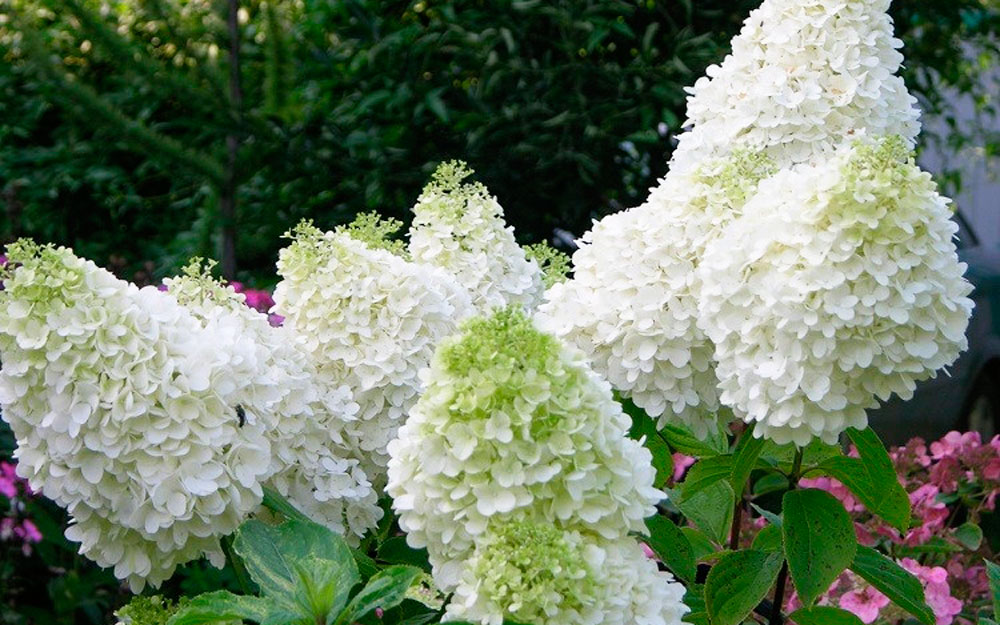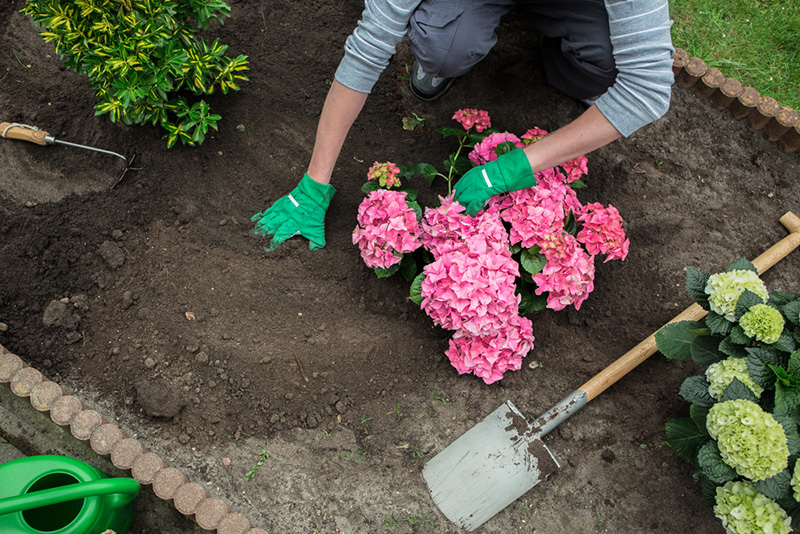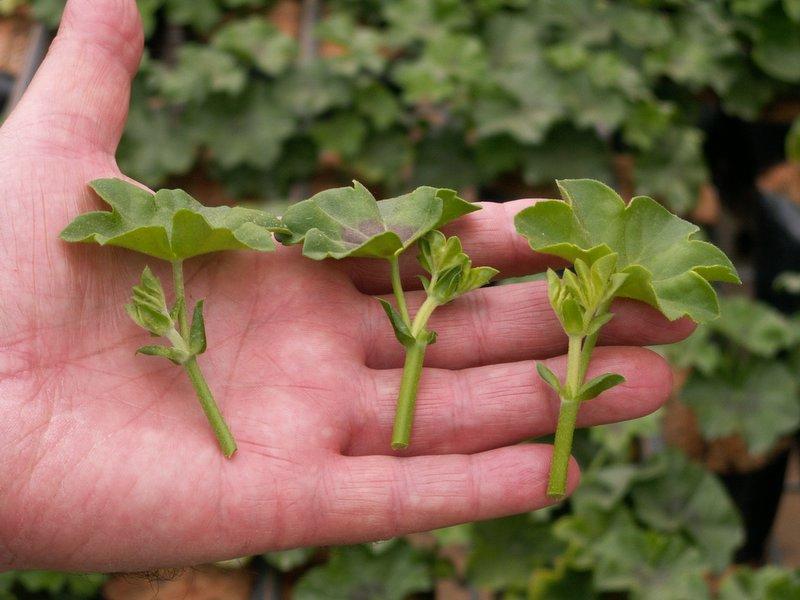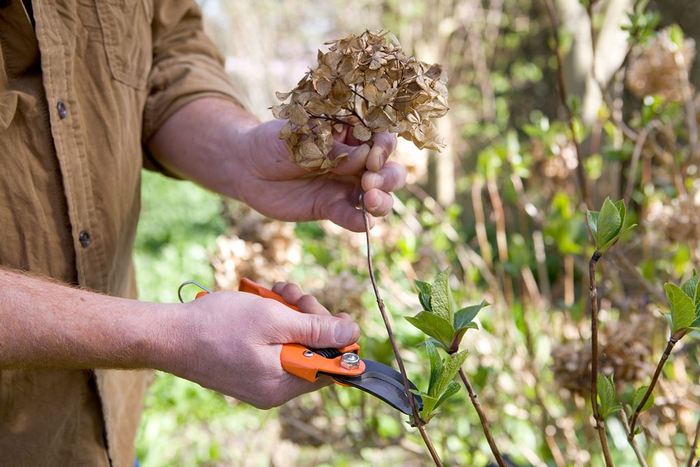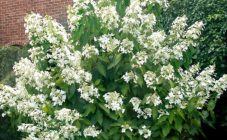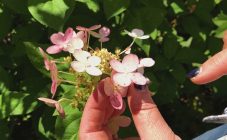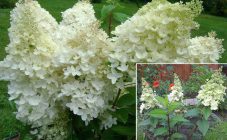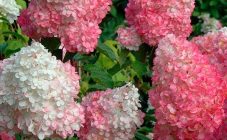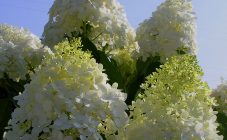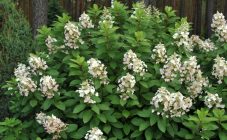Content:
Hydrangea is one of the most spectacular, beautifully flowering shrubs. It is used for landscaping parks, alleys, personal plots. There are many varieties of hydrangea, one of the most popular is Grandiflora panicle hydrangea (less often - just Flora).
Characteristic
Hydrangea paniculata Grandiflora belongs to the old varieties, it was known in East Asia as early as 1860. At that time, the bushes could reach 10 m, modern specimens are of more modest size.
The main characteristics of the variety include:
- high decorativeness during flowering;
- growth rate (up to 25 cm per year);
- frost resistance - tolerates up to -30 ° С, due to which it can be grown even beyond the Urals;
- resistance to disease.
Description
Hydrangea paniculata Grandiflora is a deciduous shrub reaching a height of 2 m, its diameter during the flowering period is 3 m. The inflorescences, consisting of small flowers, are pyramidal in shape and can grow up to 30 cm in length. Flowers are usually sterile, do not form fruit.
At first they are painted cream, then white, gradually acquiring a pink tint. Closer to autumn, the buds become greenish-red. Hydrangea blooms begins in June and ends in late September.
The leaves of the plant are oblong, up to 12 cm in length, strongly pubescent in the lower part, especially along the veins. Hydrangea begins to bloom fully 4-5 years after planting, although the first rudiments of buds already appear for 2-3 years.
Landing
The landing site must be chosen diffusedly illuminated by the sun. From too bright rays, the decorative appearance of the bush is lost. The soil should be fertile, neutral or acidic. Sandy soils need to be oxidized with peat, sawdust, and coniferous soil.
Planting instructions:
- The plant is planted in spring, from March to May, or in autumn, from September to October;
- When planting several bushes, a distance of 2-2.5 m is maintained between them;
- The substrate is prepared from a mixture of turf, peat, compost and soil in a ratio of 2: 2: 1: 1. Pine needles are added to maintain the acidity level.
Planting hydrangeas step by step:
- a landing pit with a diameter of 50 cm, a depth of 40-60 cm is dug;
- a prepared substrate is poured into the hole and left for 1 week for natural tamping;
- after a specified time, take out the seedling from the container;
- plant it in the center of the pit without breaking an earthen coma;
- the soil is slightly compacted, spilled with water.
Reproduction
Hydrangea Grandiflora paniculata at home propagates vegetatively in several ways:
- By dividing the bush. The procedure is carried out in the spring before sap flow or in the fall. A part of the shoot with the root is separated from the mother plant and planted separately;
- By cuttings. The tops of the shoots are cut off in June-July, which are then planted in the shade, and covered with a glass container. Caring for them consists in watering and airing. After rooting, the cuttings are planted in separate holes;
- Layers. The lower branches are stripped of foliage, laid in furrows, and sprinkled with earth. The rooting site is watered with water. When the root system is formed on the shoot, it is dug up and transplanted.
Growing by seeds is laborious, long-term, and is usually not used at home.
Care
In order to preserve the decorative appearance of hydrangea for a long time, it must be systematically looked after. For this, the activities described below are carried out.
Watering
Although this variety is positioned as drought tolerant, it needs frequent moisture to maintain high-quality inflorescences. Every week you need to bring 1.5-2 buckets of water under the bush. Water the plant in the morning or evening with warm water. If the roots are exposed from the procedure, the bush must be spud with peat.
In too hot weather, large-flowered hydrangea is watered 2-3 times a week. In rainy summers, the frequency of watering decreases. With waterlogging of the soil, the bush can be affected by fungal diseases.
Top dressing
For abundant growth of shoots and buds on them, hydrangeas require constant feeding. It is performed several times per season.
- In the spring, organic fertilizers are used: mullein or bird droppings (1 part) are stirred in water (15 parts), infused for 1 day. Hydrangea is poured with a solution at the rate of 2 buckets under a bush;
- At the beginning of budding, top dressing is performed, consisting of the following components: 20 g of ammonium nitrate, 30 g of superphosphate and 30 g of potassium salt, diluted in 1 bucket of water;
- In summer, plants are fertilized with complex feeding for decorative flowering plants;
- Autumn top dressing, consisting of 50 g of superphosphate and potassium salt, applied under the bush, will help him survive the frosty winter.
Pruning
The number of shoots on hydrangeas increases every year. In this case, the quality of the inflorescences may suffer: when the bush thickens, their number decreases, just as they themselves become smaller. For this reason, the plant must be formed at the stage of its growth. Hydrangea can be grown not only as a bush, but also as a tree, removing unnecessary shoots from the root itself.
Pruning starts the process of forming new branches and inflorescences. To accelerate their growth, the lashes are cut into 2-3 buds. For rejuvenation, all branches are cut off at the root. In the next season, the hydrangea will release many young shoots. In addition, broken, diseased, dried out branches are constantly cut off.
Diseases and pests
Hydrangea can be affected by fungal diseases. This is usually due to improper care. For example, with abundant watering of a bush in a cold summer, rot can form on the roots. If the bush is too thick, the crown is poorly ventilated - this is also good conditions for the development of pathogens.
Treatment with antifungal drugs does not always give a positive result, therefore it is necessary to constantly carry out preventive procedures. One of them is spring and autumn spraying with Bordeaux liquid or fungicides, according to the instructions.
If a spider mite or aphid is found on a plant, the plant is sprayed with a solution of any insecticide. To prevent their appearance, you can use the following folk remedy:
- 150 g of garlic are stirred in 5 liters of water;
- the mixture is left to infuse for 2 days;
- after a specified time, add 50 g of soap for better adhesion;
- the mixture is filtered through cheesecloth;
- spray the entire aboveground part with a solution, as well as the ground.
Use in landscape
Hydrangeas are highly valued in gardening design: they serve as a bright accent. They perfectly decorate fences, open farm buildings.
Paniculata hydrangea in parks is planted against the background of birches, acacias, maples, lilacs. Good neighbors for her will be the tree hydrangea Grandiflora, willow, barberry. Mixes with rhododendrons, roses, dahlias look beautiful. The luxury and neatness of the site will be emphasized by planting hydrangeas against the background of western thuja.
Hydrangea paniculata Grandiflora is loved by designers and gardeners for its spectacular appearance, long flowering, and unpretentiousness. With its help, any territory will be ennobled, sparkle with colors. Hydrangea looks beautiful when planted alone or in combination with other plants.
